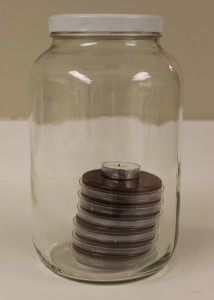 When growing microorganisms, several conditions including incubation time, temperature, pH, adequate moisture and sufficient nutrients (such as carbon and nitrogen) must be considered to ensure successful results.
When growing microorganisms, several conditions including incubation time, temperature, pH, adequate moisture and sufficient nutrients (such as carbon and nitrogen) must be considered to ensure successful results.
Even experienced microbiologists can run into growth issues with finicky microorganisms. With this in mind, we have created a series of blog posts highlighting a variety of tried and true growth methods for creating an environment best suited for reproduction of various microorganism species.
Method for CO2 Dependent Microorganisms
Who put a pickle jar in the laboratory? Before you assume the lab technicians had a hankering for picked eggs, remember that a large jar and a cheap, unscented candle (also known as a “candle jar”) can be used to create a CO2 enriched environment. Whether your lab is using candle jars or a CO2 incubator, our recommendations below will help you achieve growth success for CO2 dependent microorganisms.
Media: Chocolate agar

Haemophilus influenzae on chocolate agar
Temperature: 35°C
Atmosphere: CO2 enriched environment
Growth Time: 24-48 hours
The following microorganisms can grow using this method:
- Acetobacter sp. (incubate at 25°C)
- Actinobacillus sp.
- Agregatibacter sp.
- Capnocytophaga sp.
- Eikenella sp.
- Haemophilus sp.
- Neisseria sp.
Check out our Growth Requirements for detailed descriptions of all our growth methods.





In ecology , primary production is the synthesis of organic compounds from atmospheric or aqueous carbon dioxide . It principally occurs through the process of photosynthesis , which uses light as its source of energy, but it also occurs through chemosynthesis , which uses the oxidation or reduction of inorganic chemical compounds as its source of energy. Almost all life on Earth relies directly or indirectly on primary production. The organisms responsible for primary production are known as
HELP:
SO, you know how you can increase the CO2 concentration in a candle jar by including a plate full of E. coli? What is the name of that effect?
Rebecca – It falls under Fortner’s Principle. You can learn more about it here: https://tinyurl.com/y36vuye4